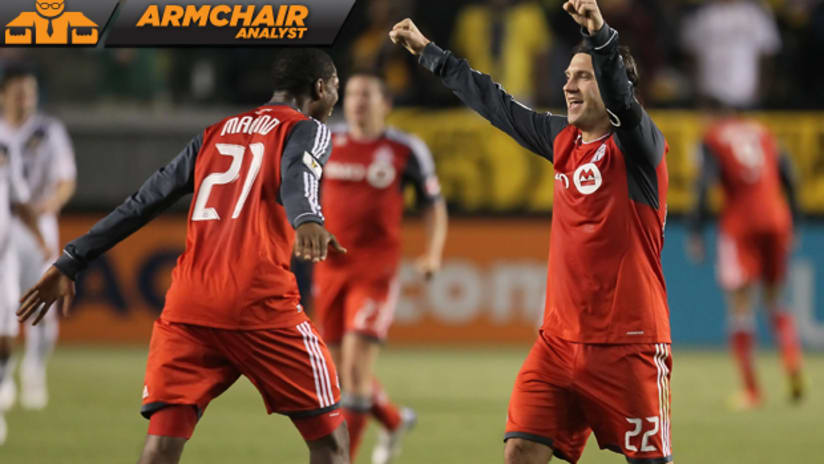After the Santos Laguna vs. Sounders debacle on Wednesday night – the last 30 minutes of which seemed to play out like the last scene in se7en, except on repeat and without the happy ending – I steeled myself, girded my loins, poured a scotch and sat down to enjoy some good, old fashioned MLS-on-MLS action.
The “good” part was subjective; LA fans would probably choose a different adjective. Hell, Toronto fans probably would as well – “good” isn’t a strong enough word for what was truly a touchstone performance.
But the “old fashioned” part cannot be disputed. Because two hours after the Sounders were sent packing, Aron Winter & Co. did to the Galaxy what Steve Sampson was trying to do to Germany, Iran and Yugoslavia 14 years ago. Somehow we’d all fallen into a time warp – except in this obviously altered reality, the 3-6-1 worked.
Go back to 1998 and recall, if you will, the mad plan of the then head coach of the US national team. Sampson had come up with something, it was thought, truly revolutionary. It was a formation that could allow him to field Claudio Reyna along with two pure defensive midfielders behind him, and do so without sacrificing attacking verve. It was something that would take advantage of the US speed on the flanks – be it Cobi Jones, Earnie (then Ernie) Stewart or Frankie Hejduk. It was something, he presumably hoped, that no one would truly be prepared for.
Sure, it left Eric Wynalda alone against a German backline that had just won the European Championship two years previous (Waldo famously explained, "I had three of the best defenders in the world on my back," when asked why he touched the ball but once in the first half). And it left Thomas Dooley to sweep against a team that, if nothing else, knew how to punish a side with a slow, aging sweeper.
And, in the end, it just didn’t work. It looked nice on diagrams, and it certainly invoked “the right of the weak” – Sampson’s team would destroy the game if they couldn’t play it.
But all it took was a Jens Jeremies kidney-shot to Reyna and some classic German know-how to end the 3-6-1 before it even began. In the decade-and-a-half since, the formation has become a bit of a punch line in American soccer circles.
Fast forward to Wednesday. There were the Reds, for all intents and purposes, playing a 5-2-3 in the first half, with Torsten Frings (Jeremies’ heir in defensive midfield for Germany, coincidentally enough) sweeping between two classic center backs (Ty Harden and Miguel Aceval) and two “fullbacks” (Ashtone Morgan and Richard Eckersley) staying wide and deep.
That left Julian de Guzman and Ryan Johnson somewhat hopelessly outgunned in midfield, ceding plenty of time and space to the Galaxy to put in through ball after through ball. That LA didn’t convert can be chalked up to Frings, Milos Kocic and one fortunate offside call.
In the second half, though, Winter got smart. He subbed off Joao Plata, an attacker, for Terry Dunfield, an all-action, box-to-box midfielder who’s only too happy to do the work of two men.
Winter also pulled Nick Soolsma back deeper into the right-center channel, and pushed Johnson out into the left-center channel. Lastly, he had Eckersley and Morgan push higher and wider, until they were actually playing farther up the pitch than de Guzman (and his sub, Luis Silva) and, for large stretches, Dunfield.
Blammo, that’s a six man midfield. Now it was LA who were outgunned.
The Galaxy suddenly didn’t have as much time and space to send in those through balls, and eventually David Beckham drifted over to the right touchline where proceeded to whip in 13 crosses, only two of which OPTA rated as “good.”
For Winter, that was achievement No. 1.
Achievement No. 2 relates to the play of Danny Koevermans, who was left all alone up top.
But unlike Wynalda in ’98, the big Dutchman wasn’t facing three of the world’s best defenders, and he seemed to have a clearer idea of how a No. 9 should operate in the system. Koevermans ended up doing the smartest thing he could: Plant himself directly between A.J. DeLaGarza and Tommy Meyer, and stay a half-step offside for the entire time he was on the pitch.
This forced DeLaGarza and Meyer to play deeper than they wanted, and to try to time their traps toward a center forward who was only going to put himself into play half the time at best. In the process that opened up lanes for midfield runners – often called “The third runner” – to get onto crosses whenever TFC launched a counterattack.
You’ll recall that this is exactly how Soolsma scored the series-winning goal. For Winter, that was achievement unlocked. Minutes later, he subbed defender Aaron Maund on for Koevermans, retreating into purely a rearguard action.
It still took a good deal of luck and some pretty poor finishing from LA for Toronto to advance, though as we all know, that’s often the case in knockout rounds. And it’s worth noting that Santos Laguna – TFC’s next opponent – aren’t particularly short of finishers these days, so Winter had best have another tactical trick up his sleeve for the semis.
For one night, though, the 3-6-1 looked and played exactly how it was supposed to 14 years ago. That doesn’t do much to soothe the wounds of Yanks who are still stung by the 32nd-place finish in 1998, but I sincerely doubt Torontonians care much about that. They’ll be too busy celebrating the coach and the team that turned a punch line into a victory.












